- Details
- Category: War Memorials
Summary of the Men on the Bangor Railway Institute Boys’ Corps War Memorial
Bridget has been researching the names on a war memorial plaque that used to be in St David's church Glanadda, which has now closed. The plaque has been moved to Bangor railway station. Here is a list of the names and their details.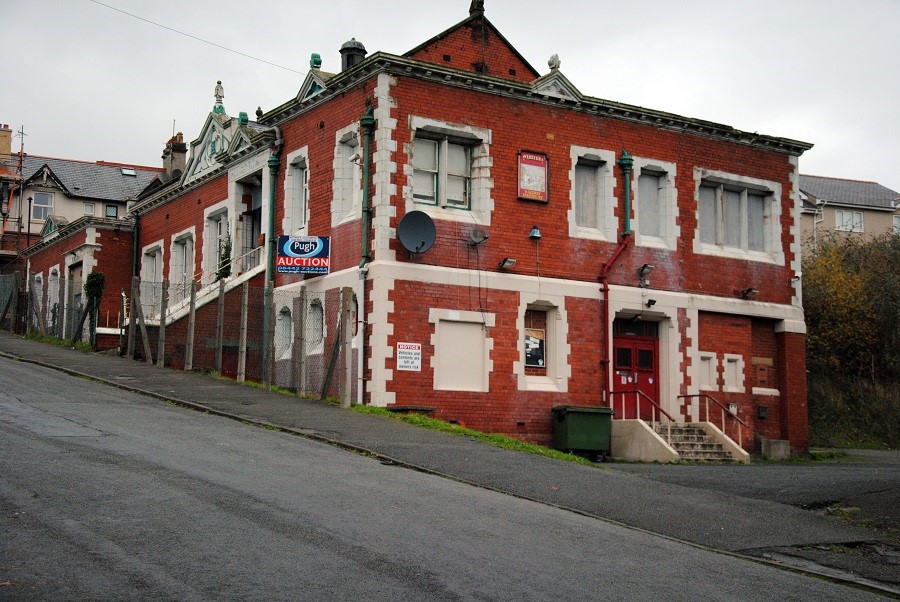
The Bangor Railway Institute, just before demolition
Photo courtesy Jimmy Johnson
01 Caesar Alfred Cooil – son of Caesar and Elizabeth Cooil of 2 Orme View, Euston Road and brother of John; educated Friars School, Bangor and University College of North Wales (Bangor), played football for the North Wales Coast League; Assistant Master at King Edwards’ School in Nottingham; served as Captain Midland Royal Garrison Artillery; while home on leave was sent to the military Hospital in Glanadda, Bangor, gas poisoning had caused pneumonia; died Monday 11 November 1918; age 27; buried Glanadda Cemetery, Bangor
02 - John Dentith Cooil – son of Caesar and Elizabeth Cooil of 2 Orme View, Euston Road and brother of Caesar; educated Friars School, Bangor; an ‘Office Youth’ with the LNWR; served as Private 25453, 1st Battalion South Wales Borderers; was reported missing, thought to be a prisoner of war; body found in 1920, identified by initials ‘JDC’ on cigarette case; died Saturday 10 November 1917; age 20; buried Tyne Cot Cemetery, Belgium
03 - William Cox – son of John Cox of 30 Albert Street; a Mason’s Labourer on the LNWR; served as Lance Corporal 1066, 1st/6th (Carnarvonshire & Anglesey) Battalion Royal Welsh Fusiliers; wounded in action at Gallipoli, put on hospital ship for Egypt; died at sea Saturday 21 August 1915; age 25; buried at sea, commemorated Helles Memorial, Gallipoli, Turkey
04 - Alexander Scott Hill – son of Alexander Scott Hill and Margaret of Brynmair on Caellepa; educated Bethesda County School; a Bank Clerk at National Provincial Bank in Bangor; served as Private 37673 King’s Own (Royal Lancaster Regiment); died Thursday 18 April 1918; age 19; commemorated Loos Memorial, France
05 - Edgar Holland – son of Richard and Mary Jane Holland of 23 Belmont Street; served as Private 35788, 8th Battalion Border Regiment; killed in action Monday 29 April 1918; age 19; commemorated Tyne Cot Memorial, Belgium
His father and brother also served in the forces during the war
06 - John Idwal Hughes – son of Robert and Jane Hughes of Deanfield, previously 40 Penchwintan Road; Assistant Postman with GPO; served as Sapper 126633, Royal Engineers; died Monday 26 November 1917 of dysentery; age 20; buried Dar Es Salaam War Cemetery, Tanzania
07 - William Samuel Hughes – son of Hugh Owen and Jane Hughes of 5 Orme Terrace, Euston Road; a Painter on the LNWR; served as Private 1597, 1st/6th Battalion (Carnarvonshire & Anglesey) Royal Welsh Fusiliers; brought home from Egypt because of dysentery, died in West Didsbury Military Hospital, Manchester on Monday 17 July 1916; age 29; buried Glanadda Cemetery, Bangor
08 - Benjamin Roberts – son of Laura and the late John Roberts of Bangorfa, Treharris, Glamorgan (previously 13 Hendrewen Road, Bangor); a Collier in the Glamorgan coal mines; served as Serjeant 11451, 6th Battalion Dorsetshire Regiment; died Monday 23 April 1917; age 29; buried Faubourt D’Amiens Cemetery, France
09 - Robert Roberts – son of Mr and Mrs John Roberts of 9 Victoria Square, Glanadda; a labourer on the LNWR; served as Lance Corporal 1081, 1st/6th (Carnarvonshire & Anglesey) Battalion Royal Welsh Fusiliers; killed in action at Gallipoli on Wednesday 11 August 1915; commemorated Helles Memorial, Gallipoli, Turkey
10 - John Samuel Roberts – son of John and Mary Roberts of Kimberley Road, Llandudno Junction, previously of Bangor; a Shop Assistant; served as Private 37761 2nd Battalion Royal Welsh Fusiliers; died Friday 17 August 1917; age 20; buried Coxyde Military Cemetery, Belgium
11 - Robert Roberts – son of Robert and Sarah Roberts of 8 St Paul’s Terrace; possibly LNWR Porter; served as Boy 2nd Class 92385, Royal Navy, HMS Impregnable; died in Plymouth of pneumonia, Sunday 10 November 1918; age 16; buried Glanadda Cemetery
12 - Richard Thomas – son of the late Robert and Catherine Thomas of 326 Carnarvon Road; possibly ‘Deck Boy’ on LNWR; served as Private 28728, Royal Welsh Fusiliers 19th Battalion; killed in action Saturday 24 November 1917; age 19; commemorated Cambrai Memorial, France
13 - Maurice Ward – son of John and Jane Ward of 413 Carnarvon Road; LNWR joiner; served as Lance Corporal 1075, 1st/6th (Carnarvonshire & Anglesey) Battalion Royal Welsh Fusiliers; died ‘at home’ (at Military Hospital in Cambridge) Saturday 20 February 1915 of diabetes; age 24; buried Glanadda Cemetery, Bangor
14 - Robert Williams – son of Robert and Mary Ryna Williams of 254 Carnarvon Road; a ‘Page’ on LNWR; served as Private no 28566, 19th Battalion Royal Welsh Fusiliers; killed in action Wednesday 18 October 1916; age 21; buried Philosophe British Cemetery, France
15 - David Richard Williams – an orphan brought up by his Cousin, Mrs Owen of 260 Carnarvon Road; General Labourer on LNWR; served as Private 2682, 1st/6th (Carnarvonshire & Anglesey) Battalion Royal Welsh Fusiliers; wounded after landing at Gallipoli, died on board hospital ship ‘Salta’, on the way to Egypt; buried at sea on Sunday 15 August 1915; age 21; commemorated Helles Memorial, Gallipoli, Turkey
16 - James Wyllie MM – son of Mr and Mrs James Wyllie of 27 Caellepa; served as Private 5317, 2nd Battalion Royal Welsh Fusiliers; killed in action when a German bomb exploded on their section of trench causing ‘Red Dragon Crater’ on Thursday 22 June 1916; age 19; bodies discovered in 1924, identified by possessions; re-buried Cabaret-Rouge British Cemetery, France; Awarded Military Medal & Mons Star Medal.
Of the men lost at Red Dragon Crater, four men of RWF 2nd Battalion were together; one other was Thomas Crowe Williams who is remembered on the Beaumaris War Memorial, outside the church.
Brother, David Wyllie, served as a Telegraphist in the Royal Navy
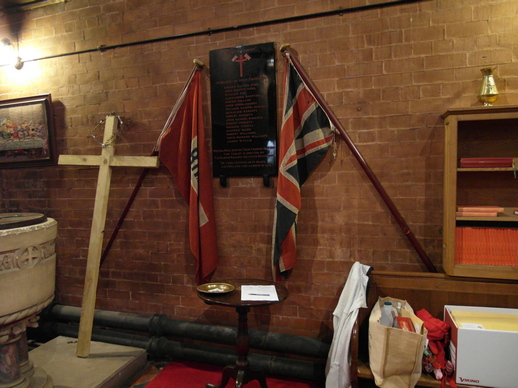
The original location in St David's church
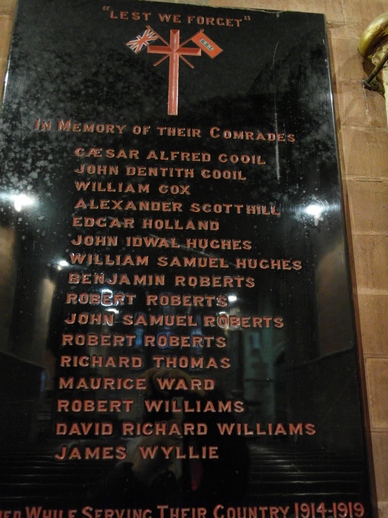
The unveiling of the new location
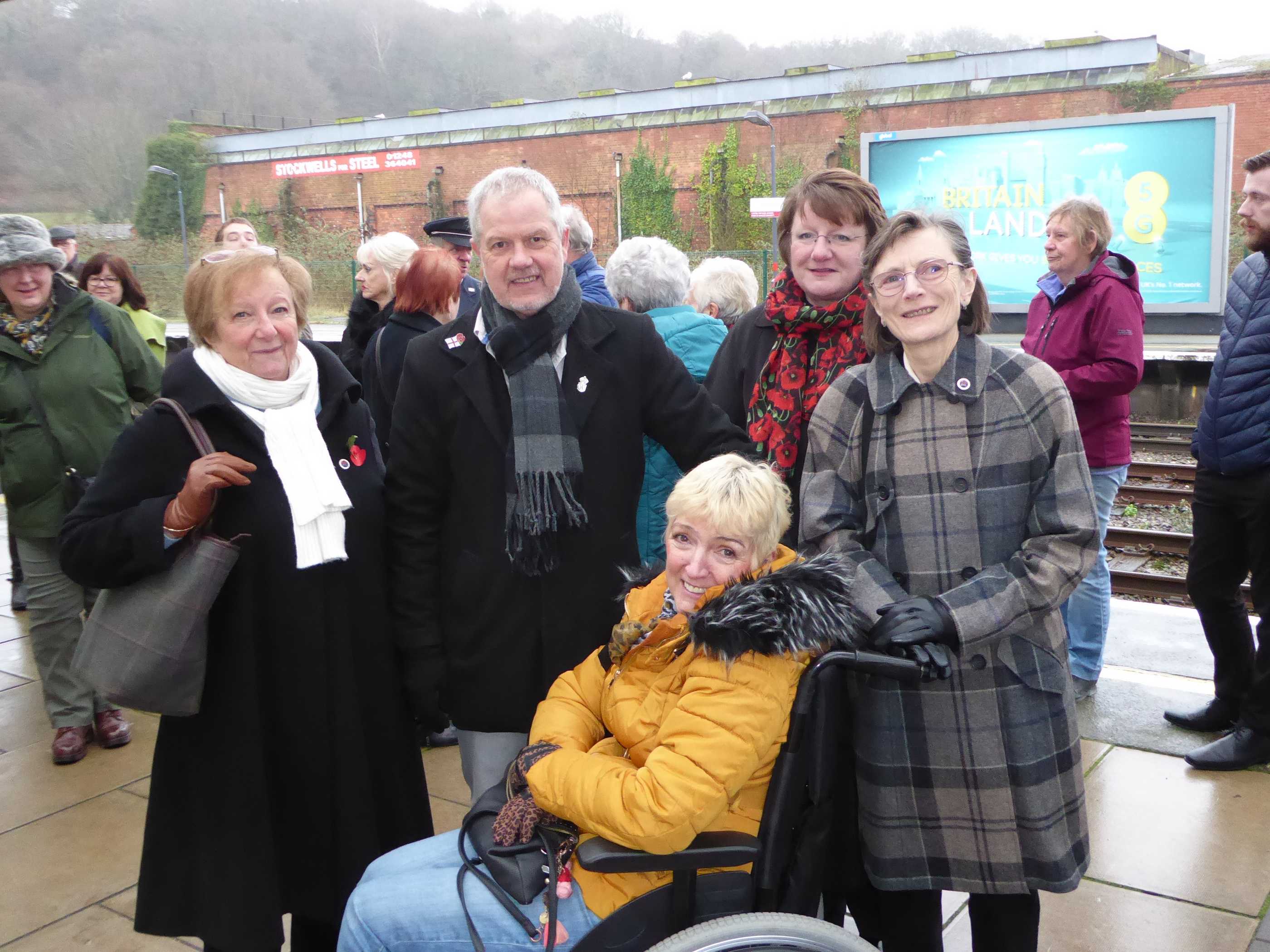 Some North Wales WFA members at the unveiling in Bangor Station 24th January 2020
Some North Wales WFA members at the unveiling in Bangor Station 24th January 2020
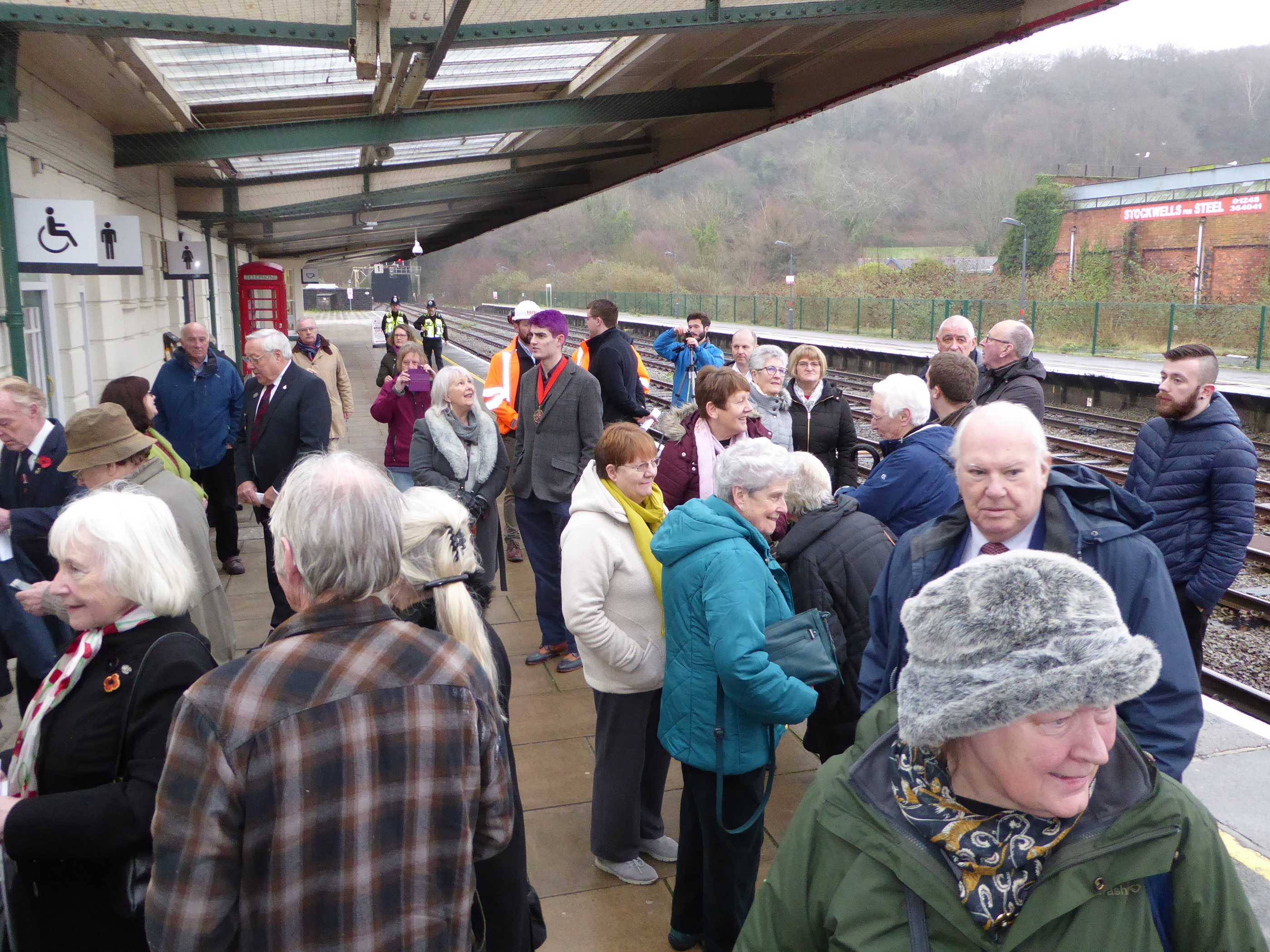
The attendees at the unveiling, including Ann and Les
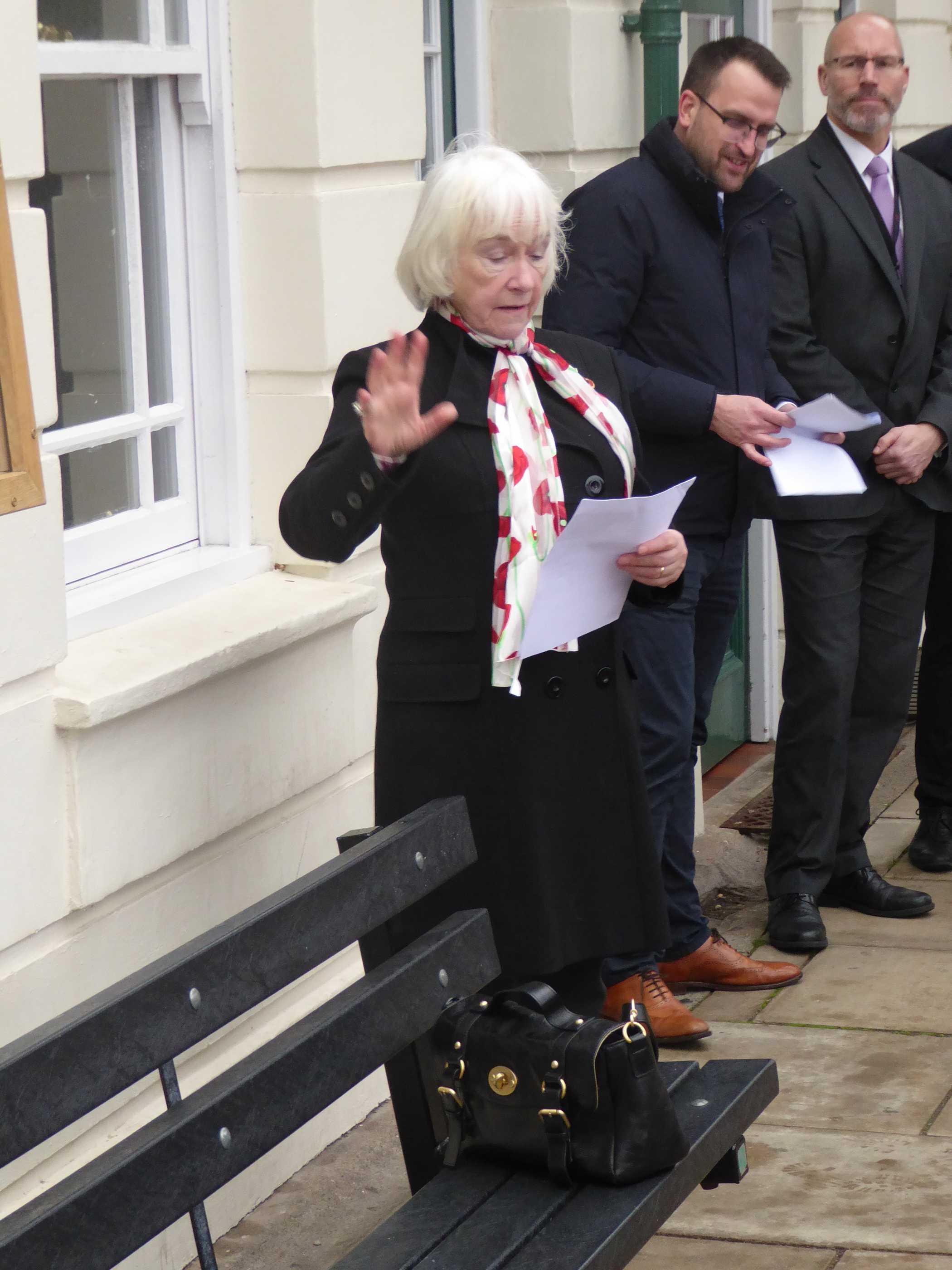 Bridget, who did the above research on the men on the plaque
Bridget, who did the above research on the men on the plaque
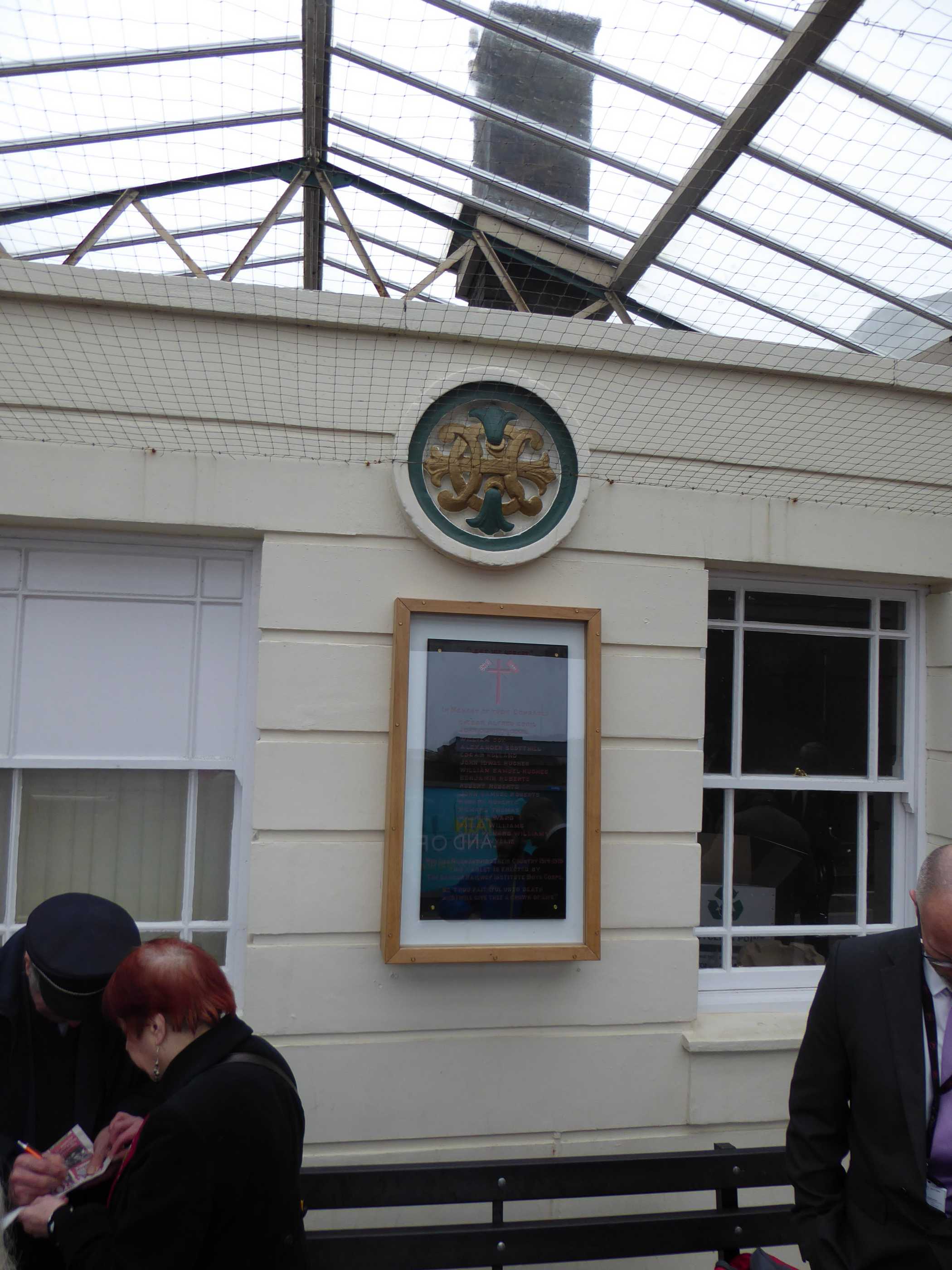 The new location, on the wall of the Grade II listed Bangor station building, on the platform from which the men left Bangor.
The new location, on the wall of the Grade II listed Bangor station building, on the platform from which the men left Bangor.
- Details
- Category: War Memorials
James Cecil Parke - a forgotten hero
James Cecil Parke was an Irish rugby international (20 caps) and captain of Ireland. He was also tennis champion at Wimbledon (mixed doubles 1914) and at the 1908 Olympics (silver medal). He won the Australian men's singles and doubles title. He reached the Wimbledon men's doubles final in 1920 when he was ranked fourth in the world, at the age of 39.
He served in WWI and survived. He was a captain in the Leinster Regiment, and was wounded in Gallipoli. He became a major in the Essex Regiment, was wounded in France and mentioned in despatches.
He spent his post-war career in Llandudno as a local solicitor with an office in Trinity Square, today the offices of Swayne Johnston, which incorporates Parke's old firm (see photo below). The building is marked with a memorial plaque.
He helped to establich the tennis courts at Craig y Don (beside the community centre where the local WFA now meet). He was an avid supporter of the Scouts, and was local commissioner and secretary of the Llandudno association.
He died in 1946 and is buried in the churchyard on the Great Orme (see photos below).
His adopted son, Thomas Robert Verner Parke (biologically his nephew) was a pilot in the RNAS and was killed in WWII on board HMS Caroline and is buried at Campbelltown in Scotland.
RTE, the Irish tv company, has produced a programme about James Cecil Parke, see the link RTE Parke
There is an exhibition about him in the County Monaghan museum. (He was born in Clones, like Barry McGuigan the boxer).
Photos below:
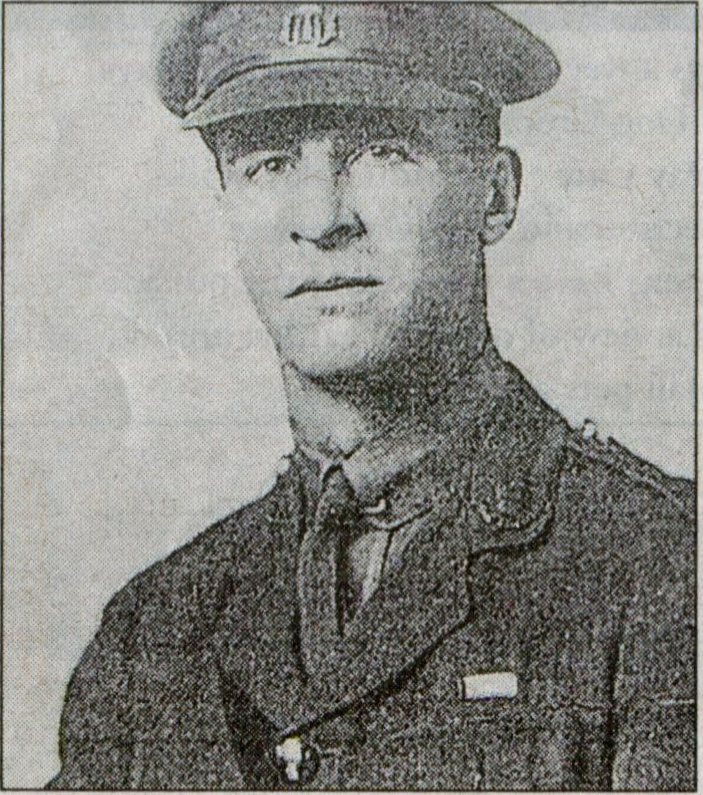 Major Parke in uniform
Major Parke in uniform His grave on the Great Orme, Llandudno
His grave on the Great Orme, Llandudno
The inscription on the headstone The memorial plaque at 17 Trinity Square, Llandudno, listing his sporting achievements.
The memorial plaque at 17 Trinity Square, Llandudno, listing his sporting achievements.
 The nameplate there today, recording the old firm with Parke's name in the title.
The nameplate there today, recording the old firm with Parke's name in the title.
- Details
- Category: War Memorials
Lieutenant Henry Pritchard
Royal Welsh Fusiliers, 16th Battalion
attached Hood Battalion, Royal Naval Division
Pilot, Penmon
In order to understand the circumstances of Henry Pritchard’s life, it is helpful to look further back at the area where he was brought up. The house his family lived in is called ‘Black Point’ in the Census of 1901 . In Welsh it is ‘Trwyn Ddu’, a direct translation. It is a piece of land on the Isle of Anglesey, jutting out into the Irish Sea. The small island close by is called ‘Ynys Seiriol’, ‘Priestholm’ or ‘Puffin Island’.
 Seiriol was a Celtic Saint who lived close by, and Penmon Church is dedicated to St Seiriol. For about 1,000 years there has been a monastery in this area. As you approach Black Point you will see some of the Monastery buildings and there is an even earlier building on Puffin Island.
Seiriol was a Celtic Saint who lived close by, and Penmon Church is dedicated to St Seiriol. For about 1,000 years there has been a monastery in this area. As you approach Black Point you will see some of the Monastery buildings and there is an even earlier building on Puffin Island.
As with any stretch of rocky shore, there is a danger to shipping. In 1831 the ‘Rothsay Castle’ was lost on the nearby Lavan Sands with the loss of 130 lives out of 150 passengers. This was the latest in a series of disastrous shipwrecks – there are many shipwreck victims buried in this Churchyard, Beaumaris and other churchyards round the coast of Anglesey.
As a result of this tragedy, in 1832 a Penmon Lifeboat was established, and the Penmon Lighthouse was completed in 1838. The following year, Trinity House built two fine cottages for the lighthouse keepers and their families. The pilot families lived close by in a modest property called ‘Pilot’ at Penmon (see photo above). More recently two Coastguard houses were built, and the monastery building next to the Church was used as a house. So there was quite a community in a small, remote area. This is the community into which Henry Pritchard was born. We may guess that as the children grew up, they would also learn to crew the lifeboat and to row the Pilots out to the ships.
Penmon Pilots were men who rowed out to the ships in the Irish Sea, to guide them through the dangerous waters of the Menai Strait. There are still Pilots on Anglesey who board ocean going container ships, to guide them into the docks at Liverpool. These men have vital knowledge of the sea in their area: they know about invisible rocks and dangerous currents. They also formed the local crew of the Lifeboat which was at Penmon until 1914 when it moved to Fryars Bay and was called the ‘Beaumaris Lifeboat’.
By 1914, William Pritchard had been Coxswain of the Lifeboat for many years, but because there was less need for Pilots, other Pilot families had moved away so there was no longer the manpower to crew a Lifeboat. In 1918 a ‘Certificate of Service’ was awarded to William Pritchard, Pilot who had served as coxswain of the Penmon Lifeboat for over 24 years, and had been a member of the crew before that. He had previously earned two Silver Medals for sea rescues.
In Penmon churchyard there are several family memorials to men who died in war and whose bodies are buried elsewhere. One of these is Henry Pritchard, son of William Pritchard, a Pilot and decorated lifeboat coxswain.
Henry was born in January 1890, the son of William Pritchard (pictured below right) and Elizabeth who had lived at Black Point since about 1880. 
Other children were: John born in 1879, William Owen born 1887 (died in infancy), Mary born in 1885 who died at the age of 10, Willie born 1895 who died at the age of 22 and Elizabeth the youngest.
In the Census of 1891 the family lived at ‘Black Point, Penmon’. They were one of the Pilot families living in a house called ‘Pilot’; now the Pilot House Café. William was the Head of the House, his wife Elizabeth and children: John, Margaret, Mary and Henry (aged 1). On the day of the 1901 Census, William and Elizabeth lived there with their children; Henry, William and Elizabeth.
The children probably attended the local primary school in Penmon. Henry went on to Beaumaris Grammar School, so we can be sure that he was a bright lad.
The newspaper report below states that Henry Pritchard served in the Lighthouse service, Trinity House. There is also a record of Trinity House service for his elder brother, John Pritchard. It seems a likely career for a young man of his background and intelligence; it could explain why John did not serve in the war – he could have had a ‘reserved occupation’ - his skills were of more use at home than in war. Henry chose to volunteer for military service.
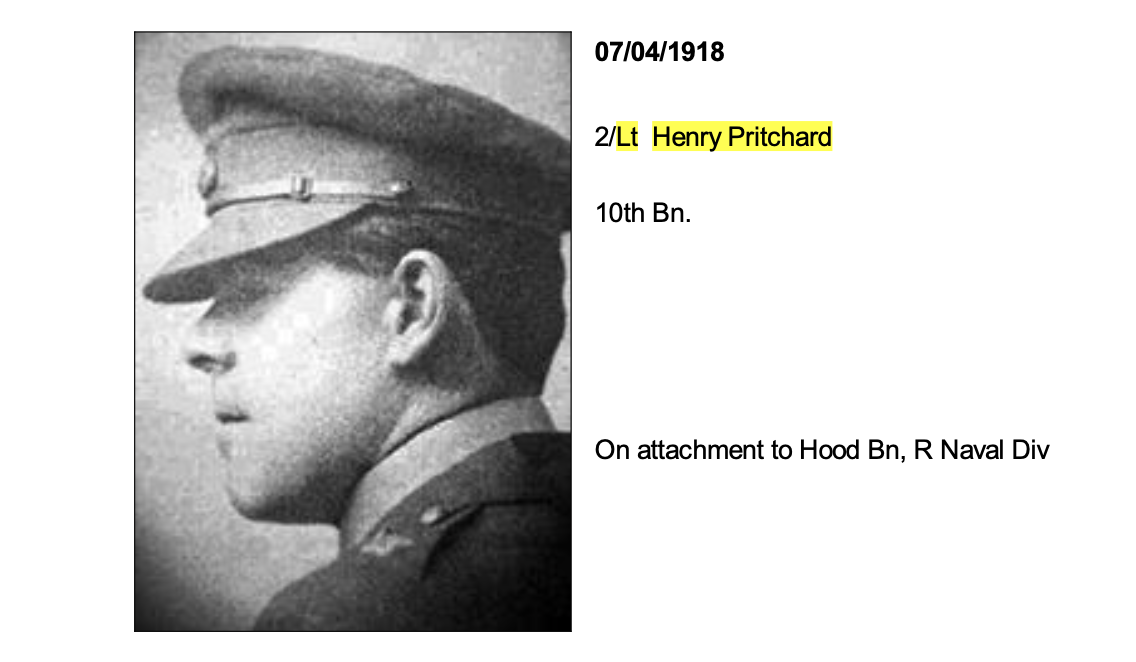 One day, as I enjoyed a coffee outside the Pilot House Café, I was musing on this career move – and the more I thought about it, the better the prospect became. Try sitting outside the small building that served as home to three families, and look at the houses next door – the Trinity House cottages - they are mansions in comparison!
One day, as I enjoyed a coffee outside the Pilot House Café, I was musing on this career move – and the more I thought about it, the better the prospect became. Try sitting outside the small building that served as home to three families, and look at the houses next door – the Trinity House cottages - they are mansions in comparison!
In December 1914, there is a newspaper report of two Penmon men: Henry Pritchard and John Henry Parry of Coedwig Terrace volunteering to join ‘Kitchener’s Army’. They were both members of Capel Tŷ Rhys, the local Methodist Calvinist Chapel and associated Sunday School. Members of the Chapel Sunday School gave them illustrated copies of the Bible.
‘Penmon / Prynhawn Sul cyflwynodd aelodau Ysgol Sabothol y M.C., perthynol i’r lle uchod, anrhegion o Feibiau darloniadol id dau fachgen ieuainc o’r ardal, sef Mr Henry Pritchard, Trwyn Du, a Mr John Henry Parry, Coedwig Terrace, ar eu hymrestriad ym Myddin Arglwydd Kitchener. Y mae Mr Henry Pritchard wedi gadael ei gwydd yngly a’r Trinity am ysbaid y rhyfel, i wasanaethau dros ei Frenin a’i wlad; felty hefyd Mr John Henry Parry, gadawodd yntau ei waith a’i cartref ym Mhemnon i’r un amcan, ac yr oedd y ddau adrag dros y Saboth. Cyflwynwyd y Beiblau iddynt, ar ran yr ysgol, gan cu hathraw, Mr John Roberts, Pwll Crwn, a whoed iddynt amrwy gynghorion buddiol i lynnau byd y gallont wrth y rhai hynny fyddent yn talu parch i grefydd Crist, gan eu barong Hefyd i wisgo holl arfogaeth Duw, fel y gallont sefyll yn erbyn cynwynion dinfol. Gyda golwg ar wu dyfodol, yr oedd pawb yn dymuno a goro iddynt ymhob ystr, ac yn bennaf am i Arglwydd y Lluoedd fod gyda hwy, a Duw Jacob yn amdiffynfa iddynt – Aelod.’
Henry went to the Royal Welsh Fusiliers Signals Section where, in time, he was promoted to Sergeant. By July 1917, the paper reports that Henry has entered Cadet School in order to train as an Officer.
‘Penmon / After twenty months of active service at the front, Sergt. Harry Pritchard, son of Mr Wm. Pritchard, pilot, has entered a cadet school with a view of qualifying for a commission. Two months after the outbreak of war he joined the R. W. Fusiliers’ Signal Section, and was soon promoted to the rank of sergeant. For the greater part of the time he was attached to Headquarters Staff.’
In February 1918 Henry returned to the front, as a 2nd Lieutenant with the RWF 16th Battalion, but this time attached to the Royal Naval Division, Hood Battalion. (Note, that although the CWGC lists him as serving with the 16th Battalion, the Medal Roll Index Card lists him with 10th Battalion). The Royal Naval Division men had volunteered for service with the Royal Navy, but at that time were needed in the front line more than at sea. Quite often Officers were moved round from one Regiment to another. In this case, with his knowledge of the sea, Henry would have fitted in quite well with a Naval Battalion.
Henry was killed ‘in action’ on April 7th 1918. He was probably killed by a bombardment while his company was relieving the Bedfordshires at the front line (see ‘The Wartime Memories Project’ on the internet). From the local newspaper reports, he had served about eight weeks as an Officer, two weeks more than the average for the time.
In November 1917, Henry’s younger brother Willie died at the age of 22. William Pritchard, their father, died in early 1919 his health having failed after the death of his wife in 1911 and the loss of two sons in 1917 and 1918.
Memorials to Henry Pritchard
Henry is commemorated on a family gravestone in Penmon Churchyard ‘Hefyd am, Lieut. Henry Pritchard yr hwn a gwympod ar faes y gwaed yn Ffrainc Ebrill 7ed 1918 yn 28 mlwydd oed’. (See photo below).
‘Also of Lieutenant Henry Pritchard, fell on the field of blood in France April 7th 1918, 28 years old.’
In the David Hughes School, Beaumaris as an old Biwmarensian: 1914 – 1919 Praise God for the service of these Biwmarensians who, amid the manifold perils of the Great War were found faithful until death - Henry Pritchard
 Lt Henry Pritchard is commemorated by the Commonwealth War Graves Commission on the Pozières Memorial in France: Pritchard, Henry / Rank: Second Lieutenant / Date of Death: 07.04.1918 / Regiment: Royal Welsh Fusiliers 16th Bn. attd. Hood Bn. R.N. Div. Royal Naval Volunteer Reserve / Panel Reference: Panel 36 and 37
Lt Henry Pritchard is commemorated by the Commonwealth War Graves Commission on the Pozières Memorial in France: Pritchard, Henry / Rank: Second Lieutenant / Date of Death: 07.04.1918 / Regiment: Royal Welsh Fusiliers 16th Bn. attd. Hood Bn. R.N. Div. Royal Naval Volunteer Reserve / Panel Reference: Panel 36 and 37
On the Llangoed Village Hall memorial plaque: This Tablet is set here by the Parishioners of Llangoed, Llaniestyn and Penmon to the memory of those who gave their lives for the cause of Liberty and Righteousness in the Great War 1914 – 18 a.d. “Bravely they fought, for us they died, for us they live” - 2nd Lieut. H. Pritchard, Penmon, Killed.
In the Bangor Memorial Arch (North Wales Heroes’ Memorial Arch) opened in 1923, he is recorded under the Parish of Penmon as ‘Pritchard, H.’
In the ‘Regimental Records of the Royal Welch Fusiliers’ by Major Dudley Ward he is listed under Officers RWF / Roll of Honour – Pritchard, Henry, Temporary Lieutenant, killed in action, 07.04.18 (attached Hood Battalion).
Bridget Geoghegan 2016
- Details
- Category: War Memorials
Private John Henry Parry 15300
Royal Welsh Fusiliers, 10th Battalion
3 Coedwig Terrace, Penmon
Evan Parry and Mary (Edwards) married in late 1893. Their first son, named John Henry was born a year later. In 1897 their daughter was born, she was named Mary Jane but was known as ‘Molly’. In 1904 Hywel Glyn was born, and Gwynfryn in 1905. These two younger boys died as infants.
 Evan was a quarryman in the Penmon Quarries which at that time was a busy place. The stone was of good quality and was prized for ‘status’ buildings such as the Liverpool Dock buildings and Birmingham Town Hall.
Evan was a quarryman in the Penmon Quarries which at that time was a busy place. The stone was of good quality and was prized for ‘status’ buildings such as the Liverpool Dock buildings and Birmingham Town Hall.
We know that Evan died in 1908 at the age of 38, possibly from TB. By that date, John Henry will have been working alongside his father in the quarries. TB (tuberculosis) was endemic at the time, and it was no respecter of status. The youngest son of the neighbouring landed gentry family, the Hamptons of Henllys (just outside Beaumaris), died of TB in 1910. It is likely that the dust from quarry work will have made an illness such as TB worse, also poor living conditions – many houses were damp and overcrowded.
The family lived at 3 Coedwig Terrace, Penmon (see photo above); houses built for the quarry workers. They attended Capel Ty Rhys in Llangoed, the Methodist Calvinistic Chapel and the children attended the Ysgol Sabothol (Sunday School) for their Welsh and scripture education. For their formal education, the children doubtless attended Penmon School.
In December 1914, ‘Y Clorianydd’, a Welsh newspaper, reported: Penmon - Prynhawn Sul cyflwynodd aelodau Ysgol Sabothol y M.C., perthynol i’r lle uchod, anrhegion o Feibiau darloniadol id dau fachgen ieuainc o’r ardal, sef Mr Henry Pritchard, Trwyn Du, a Mr John Henry Parry, Coedwig Terrace, ar eu hymrestriad ym Myddin Arglwydd Kitchener. Y mae Mr Henry Pritchard wedi gadael ei gwydd yngly a’r Trinity am ysbaid y rhyfel, i wasanaethau dros ei Frenin a’i wlad; felty hefyd Mr John Henry Parry, gadawodd yntau ei waith a’i cartref ym Mhemnon i’r un amcan, ac yr oedd y ddau adrag dros y Saboth. Cyflwynwyd y Beiblau iddynt, ar ran yr ysgol, gan cu hathraw, Mr John Roberts, Pwll Crwn, a whoed iddynt amrwy gynghorion buddiol i lynnau byd y gallont wrth y rhai hynny fyddent yn talu parch i grefydd Crist, gan eu barong Hefyd i wisgo holl arfogaeth Duw, fel y gallont sefyll yn erbyn cynwynion dinfol. Gyda golwg ar wu dyfodol, yr oedd pawb yn dymuno a goro iddynt ymhob ystr, ac yn bennaf am i Arglwydd y Lluoedd fod gyda hwy, a Duw Jacob yn amdiffynfa iddynt – Aelod.
‘Two Penmon men: Henry Pritchard and John Henry Parry of Coedwig Terrace had volunteered to join ‘Kitchener’s Army’. Both were both members of Capel Tŷ Rhys, the local Methodist Calvinist Chapel and associated Sunday School. Members of the Chapel Sunday School gave them illustrated copies of the Bible.’
Young John Henry Parry had poor health for much of the war. It is thought that the route marches in training may have proved too much for his already delicate health, he returned home ‘unfit for military service’ in February 1917 and died in June 1918. He is buried in Penmon churchyard. Although his is a CWGC grave, the headstone was provided by the family and commemorates him and his sister, Molly. 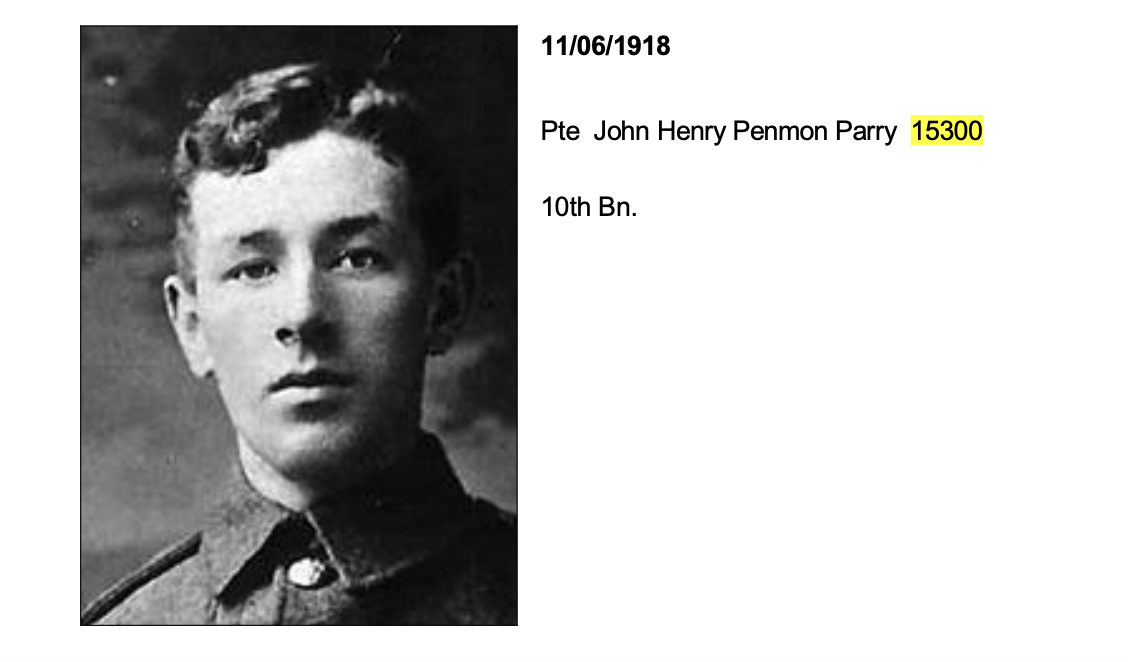
From the Royal Welch Fusiliers Museum: ‘On the subject of Pte John Henry Parry - I suppose he won't be listed in the casualty lists because he was discharged from a home service battalion due to ill health. CWGC has his service number 15300, which looks likely for a recruit joining in Sept 1914. There should be an entry for John Henry Parry in the SWB (South Wales Borderers) list.’
There are villagers who still remember ‘Auntie Molly’ teaching them at Sunday School and her mother who was the cook for the quarrymen, in the barracks building to your left as you enter the gateway to the Penmon Monastery buildings.
Memorials to John Henry Parry
His grave is the only Commonwealth War Graves Commission memorial in Penmon Churchyard (see photo below). It is a fine, carved, slate headstone which was placed by the family, so is not easily recognised. It is close to the grave commemorating his father, mother and the two babies. Both John Henry and his sister, Molly are commemorated on the stone: ‘Er serchog goffadwriaeth am John Henry annwyl fab Evan a Mary Parry 3 Coedwig Terrace, Penmon a fu farw Mehefin 11eg 1918 yn 23 mlwydd oed. Un ddwyll fel ffrynd ydoedd A rhayn aur seion oedd. Hefyd eu chwaer Molly Parry 1897 – 1962 “Gwaith a gorffwys bellach wedi mynd yn un”.’
was placed by the family, so is not easily recognised. It is close to the grave commemorating his father, mother and the two babies. Both John Henry and his sister, Molly are commemorated on the stone: ‘Er serchog goffadwriaeth am John Henry annwyl fab Evan a Mary Parry 3 Coedwig Terrace, Penmon a fu farw Mehefin 11eg 1918 yn 23 mlwydd oed. Un ddwyll fel ffrynd ydoedd A rhayn aur seion oedd. Hefyd eu chwaer Molly Parry 1897 – 1962 “Gwaith a gorffwys bellach wedi mynd yn un”.’
‘In everlasting memory of John Henry, dear son of Evan and Mary Parry 3 Coedwig Terrace, Penmon who died June 11th 1918 at 23 years old. . . . Also his sister Molly Parry 1987 – 1962 “Work and rest from now are one”.’
On the CWGC website, his entry is: J h Parry / Rank: Private / Service No: 15300 / Date of Death: 11.06.1918 / Regiment: Royal Welsh Fusiliers 10th Bn. / Grave Ref: North of East end of church / Cemetery: Penmon (St. Seiriol) Churchyard
On the Llangoed Village Hall memorial plaque: This Tablet is set here by the Parishioners of Llangoed, Llaniestyn and Penmon to the memory of those who gave their lives for the cause of Liberty and Righteousness in the Great War 1914 – 18 a.d. “Bravely they fought, for us they died, for us they live” – Private J. H. Parry, Coedwig Terr., Died.
In the Bangor Memorial Arch (North Wales Heroes’ Memorial Arch) opened in 1923, he is recorded under the Parish of Penmon as ‘Parry, J. H.’
His grave is not yet recorded on The War Graves Photographic Project.
In spite of a thorough search, I failed to find him listed in the ‘Regimental Records of the Royal Welch Fusiliers’ by Major Dudley Ward.
Bridget Geoghegan 2016
- Details
- Category: War Memorials
Lieutenant Rice Edwin Rowlands
Royal Army Service Corps
Plas Newydd, Llangoed
Rice Edwin Rowlands was born in 1880; his birth registered in Bangor. He was the youngest of 9 children to John and Ellen Rowlands. The address on his headstone is ‘Plas Newydd’ which is a fine old farmhouse in Llangoed, built by a member of the Bulkeley family and later owned by the Church. Local people still remember members of the Rowlands family; Willie, Edwin and Elin living there until about 1980. It remains a private house.
The Census of 1881 confirms this information: living at Plas Newydd in Llangoed were John Rowlands, age 43 and a Farmer of 80 acres employing 3 men; his wife, Ellin was the same age and had been born in Llangoed (John was born in Penmon). All their children were born in Llangoed: John age 17, Mary 15, Eliza 13, Ellen 10, William 9, Hugh 7, Humphrey 4, Owen 2 and Rice 10 months. Four Servants were listed; 3 Agricultural Labourers and 1 Domestic Servant.
By 1891, still at Plas Newydd in Llangoed; Ellen Rowlands was a widow and a Farmer, age 53; Mary was 25, Elsie 22, William 19 and a Farmer’s Son. All the younger boys were Scholars; Humphrey 14, Owen 12 and Rice age 10. There were 2 Agricultural Labourers and 1 ‘General Servant (Domestic)’.
In 1901 at Plas Newydd Ellen Rowlands was still a Farmer, now age 64; her daughter ‘E. A. Rowlands’, age 33 was a Hospital Nurse; ‘W. Rowlands’ age 30 was a Farmer; Ellen age 29 had no occupation; Hugh, now 26, was listed as a Farmer.
By 1911 William Rowlands was the head of the household, now age 39, married and a farmer; his wife Mary was 25 years old (also from Llangoed). William’s sister, Elizabeth A. Rowlands, age 42 lived with them – she was a District Nurse. Another sister, Ellen M. Rowlands also lived in the house, now age 40. There were 3 servants, one ‘General’ one ‘Cow Man’ and a ‘Horseman on Farm’.
Rice was commissioned 2nd Lieutenant during March 1915 into the Army Service Corps, having had no previous military service. He was recorded as being single and living at Tros Gors, Llangoed; he was of independent means.
He started his military service in Portmadoc then Denbigh and by July 1915 was in Blackheath. In January 1916 he was promoted to Lieutenant and was based in Woolwich ‘in charge of drafts being prepared for the Mediterranean Expeditionary Force’. He himself should have gone out with the Mediterranean Expeditionary Force but the order was cancelled in April; instead he was sent to Seaford that month as Requisitioning Officer. By July 1916 he was sent with the Expeditionary Force France, as Transport Officer, Supplies Purchasing Branch.
He is recorded as having 7 days leave in May 1919 and rejoined the service at the end of his leave. He was promoted to Acting Captain from June 1919. Again he was granted leave in December 1919 at which point he was in Algeria, Tunis district. He ‘Proceeded Home for demobilization 3rd June 1920’ and was finally demobbed on 17th June 1920.
At that time his next of kin were his sister, Miss E A Rowlands of Llysun, Llangoed and his brother Mr Humphrey Rowlands of Fronhal Dyserth, Flints.
There is further correspondence in the War Office archives where his brother, H Rowlands of Trosgorse, near Beaumaris writes on behalf of his sister, in late 1924; after the death of Rice Rowlands. It seems that Rice supported his sister financially and they ask for his estate to be free of Death Duties. This dispensation had been introduced to reduce hardship after the war. The War Office refused the request, stating that his death was more than 3 years since he had left the Army.
Rice Rowlands had died on 7th September 1924, at Scio House, Roehampton ‘as a result of war service’. This is reflected on his headstone inscription in Penmon Churchyard: ‘Also Rice E. Rowlands of Plas Newydd . . . who died on the 7th Sep, 1924 as a result of service as an officer in H. M. Army from 1915 to 1919 aged 44 years’. Scio House was a hospital for military officers.
The report of his death in the North Wales Chronicle of September 12th reads: ‘Llangoed – The death of Mr Price Edwin Rowlands at Scio House, Roehampton, took place on Sunday, in his 44th year, the son of the late Mr and Mrs Rowlands, Plasnewydd, Llangoed. The internment was at Penmon Churchyard on Wednesday, the vicars of Penmon and Llangoed (the Revs. D. Evans and A. H. Grey-Edwards) officiating. Mr Rowlands was of a genial disposition and was well liked. After being in business in Liverpool and London he spent ten years in Paris. In the late war he acted as an officer in France, Algeria and Tunisia. When demobilized he rejoined his old business firm at Cairo until his health failed.’
The entry in the personal column of Births, Marriages and Deaths reports his name correctly: ‘Deaths – Rowlands – September 7th, at London, Rice E. Rowlands, late of Liverpool and Llangoed. Interred at Penmon Church, on Wednesday.’
Memorials:
Rice Rowlands is buried with a grand marble headstone, in the same grave as his eldest brother, Dr John Rowlands of Bodorgan. The grave inscription says ‘In loving memory of Dr. John W. Rowlands of Bodorgan who died August 26th 1892 aged 28 years. Also Rice E. Rowlands of Plas Newydd, brother of the above, who died on the 7th Sep, 1924 as a result of service as an officer in H. M. Army from 1915 to 1919 aged 44 years.’
Because his death is some years after the war, he is not commemorated on any War Memorial, nor is he listed as a war casualty by Commonwealth War Graves Commission. Their cut-off date for someone to be classified as a casualty was midnight, 31st August 1921.
From the Royal Welch Fusiliers Museum in Caernarfon: ‘He served with the Royal Army Service Corps (later popularised as ‘Dad’s Army’). He had the rank of Lieutenant in 1918. Unfortunately another man whose death through service goes unrecognised by CWGC because he died after the 1921 cut off’.
His service is recorded along with all other local men, in the Village Hall, Llangoed: Gosodwyd y Gof Femrwn - Hwn i fynu gan Blwyfoliar(?) - Llangoed, Penmon, Llaniestyn a Llanfihangel - Gydnabod gwasanaeth teyrngarol y Molwyd a’r Morwyr isod yn y - Rhyfel Mawr Europeaidd 1914 – 19
Army / Lieut. Rice Rowlands
Bridget Geoghegan 2016